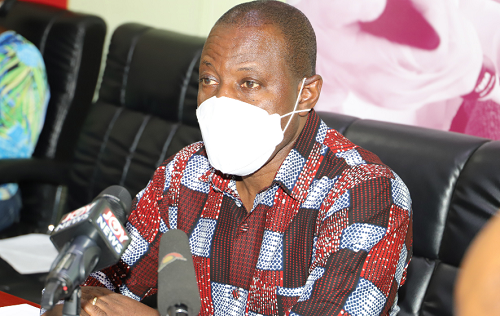
Mass drug administration for river blindness Monday
The Ghana Health Service (GHS) will from Monday to Friday September 3, this year, begin a Mass Drug Administration (MDA) for onchocerciasis (river blindness) in endemic regions in the country.
The five-day programme is targeting 4,740,039 people in 66 districts across 13 regions at no cost to the beneficiaries.
Advertisement
The regions include Ahafo, Ashanti, Bono, Bono East, Eastern, North East and Northern.
The rest are Oti, Savannah, Upper East, Upper West, Western and Western North.
At a media briefing on the MDA in Accra yesterday, the Director-General of the Ghana Health Service, Dr Patrick Kuma-Aboagye, said the exercise, which was done annually, formed part of national interventions at eradicating the public health condition, latest by 2030.
“Dosage is by height for all people above five years with height more than 90 cm using a measuring pole and administered directly under supervision. During the period, Community Drug Distributors (CDD) would visit every household to register and give out mectizan/Ivermectin tablets to eligible individuals,” he said.
Dr Kuma-Aboagye said MDA for river blindness was done twice every year to ensure that every eligible person living in a defined geographical area, regardless of whether or not they were infected or not, received a single dose of the Ivermectin drug.
He assured the public that the drugs that would be administered had been proven locally and internally to be safe and effective and pleaded with all eligible persons to make themselves available for the exercise.
Onchocerciasis/River blindness
Onchocerciasis is one of the Neglected Tropical Diseases (NTDs) caused by a parasitic worm called Onchocerca volvulus.
It is spread through repeated bites of an infected blackfly known scientifically as Simulium.
Onchocerciasis is also called river blindness because the blackfly that transmits the infection breeds in rapidly flowing rivers and streams and causes blindness, which make people living in the enclave of such water bodies more vulnerable to the disease.
People with heavy infections usually develop conditions such as unrelenting itching, unsightly skin disease, nodules under the skin, or eye disease which results in severe visual impairment and blindness.
Control
Dr Kuma-Aboagye said the country had been endemic to onchocerciasis since the early 1960s, and had been involved in its control since the inception of a WHO-led programme known as the “Onchocerciasis Control Programme, which operated for 28 years (1974-2002).
“Although the interventions focused mainly on vector control, several other approaches including mobile community treatment and later community-directed treatment with Ivermectin (CDTI) became the main control strategy in the country,” he said.
He said this year, the GHS was collaborating with some development partners to embark on the MDA against onchocerciasis in all affected districts in the country.
“This is a programme that has been implemented annually since 2007 through the technical and financial support of programme partners,” he said.
Dr Kuma-Aboagye said MDA was the provision of therapeutic dose of an effective NTD medicine to the entire target population, irrespective of infection status or symptom.
He said it was a strategy for combatting the disease and was currently recommended by the WHO as a key strategy for the interruption of transmission.
He said by treating the entire communities with safe and effective medicine, additional infections could be prevented among healthy individuals.
Writer’s email: [email protected]



